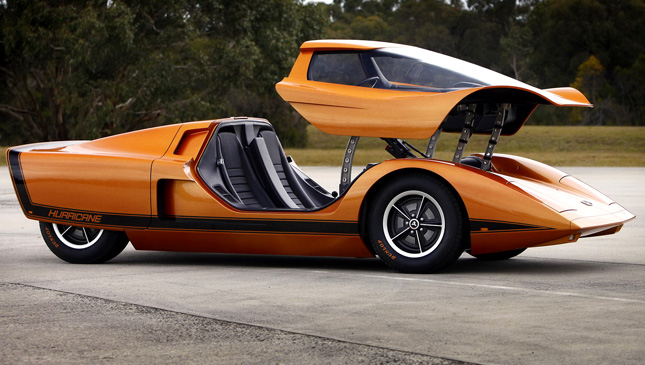Most people around the world know Holden for building the 2000s Monaro coupe and Commodore sedans but the Australian company that became a GM subsidiary in 1931 has a rich history that goes well beyond those two models.
 In 1969, the Melbourne-headquartered automaker presented its first ever concept model, the Hurricane, codenamed RD 001. It was a futuristic research vehicle described by the company at the time as an experiment “to study design trend, propulsion systems and other long-range developments”.
In 1969, the Melbourne-headquartered automaker presented its first ever concept model, the Hurricane, codenamed RD 001. It was a futuristic research vehicle described by the company at the time as an experiment “to study design trend, propulsion systems and other long-range developments”.
Some four decades years after it captured the headlines at the 1969 Melbourne Motor Show, and Holden decided it was time to restore the historic concept back to its original condition and showcase it to the public once again.
The meticulous restoring process began in 2006 with the help of some very dedicated Holden designers and engineers who volunteered thousands of hours of their time to bring back the Hurricane to its former glory.
Paul Clarke, Holden’s manager for Creative Hard Modelling who led the restoration project, said the company made sure to use as many of the original parts as possible or rebuild them using modern techniques to 1969 specification.
“The entire team has done a fantastic job in bringing this beautiful concept back to life,” Clarke said. “The Hurricane plays a crucial role in Holden’s story and the company has such a great sense of history and heritage that it was very important to bring RD 001 back to life. It’s been a challenging but incredibly rewarding process.”
The wedge-shaped Hurricane features a fiberglass body comprising of three parts: the canopy, the engine hood and body shell. The mid-engined sports car was finished in an experimental aluminium flake-based metallic orange paint.
The Hurricane features a bespoke, hydraulically operated canopy opens upwards and forward over the front wheels to allow passengers to enter the car. At the same time, the power-elevating seats rise up and pivot forward, along with the steering column. Once inside, the occupants are lowered to a semi-reclining position before the canopy closes over them.
Motivation is provided by a mid-mounted experimental 4.2-liter (253-cubic-inch) V8 engine with a four-barrel carburetor delivering 262-horses (193kW). Holden estimated that the lightweight Hurricane could complete the 0-60mph (96km/h) sprint in 5.3 seconds and the quarter mile in 13.0 seconds.
The RD 001 was equipped with many futuristic technologies for the time such as electronic digital instrument displays, station-seeking radio, automatic temperature control air conditioning and a rear-vision camera.
Perhaps one of the most standout features was an automated route finder that worked a bit like a primitive GPS navigation system. The “Pathfinder” made use of a system of magnets embedded at intersections along the road network to guide the driver along the desired route, with a dash-mounted panel informing the driver of which turn to take by illuminating different arrows, as well as sounding a warning buzzer.
Other innovations include an array of safety features including a foam-lined fuel tank, integrated roll-over bar, ignition safety locks, interior padding and a fire warning system.
“There are some genuinely remarkable ideas and technology in the Hurricane,” said former Holden Chief Studio Engineer Rick Martin, who guided the restoring team in researching the vehicle’s components, systems and history.
“From the automatic air-conditioning and magnet-based guidance system, to the inertia-reel seat belts and metallic paint, this was a car that was genuinely ahead of its time,” Martin added.
If you’d like to see the restored Holden Hurricane in person, the concept will go on display to the public at the Motorclassica, car show at the Melbourne Royal Exhibition Building from October 21-23.
VIDEO
PHOTO GALLERY














































